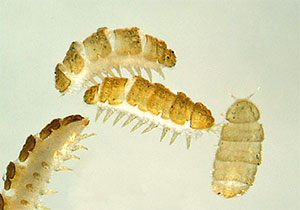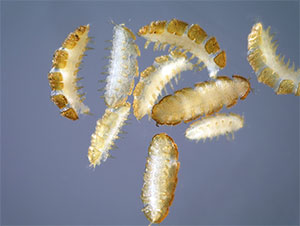|
Pauropoda

Pauropoda from the soil of a native broadleaf forest. New Zealand, North Island, Wanganui.
Common name: pauropods, pauropodans.
Scientific name: phylum Arthropoda, class Pauropoda.
Description
Pauropoda are tiny soil myriapods, 0.5-1.5mm in length, with 8-11 body segments. The body appears to have fewer segments when viewed from above, because the dorsal shields (tergites) are fused in pairs. The true segments can be seen from the ventral side, each segment bearing a single pair of walking legs. A characteristic feature of pauropods is their branched antennae.
Pauropoda are eyeless, and the head itself is poorly developed. Some Pauropoda are more strongly sclerotized (see images on this page) and move slowly, others are pale in colour and are able to run quickly.
Notes on biology

Pauropoda, New Zealand. The animals are slightly distorted
from storage in alcohol.
The Pauropoda are a rather obscure and poorly studied group, and relatively little is known about their biology, feeding habits, or ecosystem role. Pauropoda are thought to feed on soil fungi, and decaying organic matter of plant and animal origin. Some Pauropoda have grinding mandibles and may feed on solid food, while others have poorly developed mouthparts (Scheller, 1990).
Pauropoda have separate sexes. In some species males have not been observed — these species are thought to be parthenogenetic. Females deposit eggs on the substrate. The development is direct — larval stages generally resemble adult Pauropoda, apart from a smaller size, fewer number of body segments and different number of setae. Pauropoda grow through a series of moults.
Where to find them?
In New Zealand Pauropoda can be found in
the same habitats as other small soil arthropods — in
leaf litter, under moss and rocks, in decaying wood, or under
the bark of decaying logs. Although these animals are not
rare, they are not numerous and their distribution is patchy.
Because of their small size, Pauropoda are not immediately
apparent to an observer. The best way to collect them is by
using a Berlese (Tullgren) funnel. Collected Pauropoda can
be preserved in 75% ethanol. More information on collecting
and examining Pauropoda can be found in Scheller (1990).
Distribution and conservation
Five families and more than 500 species
of Pauropoda have been described worldwide. About 100 species
are known from North America, 19 species from Tasmania, 18
species from Australia. There is some data on pauropod diversity
in Europe, Japan, and South America. Very little information
exists on New Zealand Pauropoda.
Included images:
- Order Tetamerocerata
- Family Eurypaurpodidae
- Unidentified species - Wanganui National Park, WI, North Island
Further information on New Zealand
Pauropoda:
Scheller U., Barratt B.I.P. 2012. Pauropoda
(Myriapoda) from indigenous high-country tussock grassland
in New Zealand with descriptions of two new genera and eight
new species. Aust. J. Entomology 51(1): 28-46.
Scheller U., Minor M.A. 2010. New records
of Pauropoda (Myriapoda) from New Zealand with descriptions
of four new species and a new family Eirmopauropodidae.
New Zealand Journal of Zoology 37: 323-337.
Chamberlain, R.V. 1920. The Myriapoda of
the Australian region. Bull. Mus. Comp. Zool. 64, p. 82-84.
Remy, P.A. 1956. Sur quelques pauropodes
de Nouvelle-Zélande. Bull. Mus. Hist. Nat. (2)28, p.
213-217.
Remy, P.A. 1956. New Zealand Pauropoda
in the Canterbury Museum. Rec. Canterbury Mus. 7, p. 3-28.
Scheller, U. 1974. Two Pauropodidae Species
(Myriapoda, Pauropoda) from the Subantarctic Crozet Islands.
Entomol. Scand. 5, p. 59-65.
Scheller, U. 1990. Pauropoda. In: Dindal
D.L. (ed.). Soil Biology Guide. J. Wiley & Sons, New York,
p. 861-890.
|